Shop Permanent Jewelry: Your Guide to Lasting Adornment
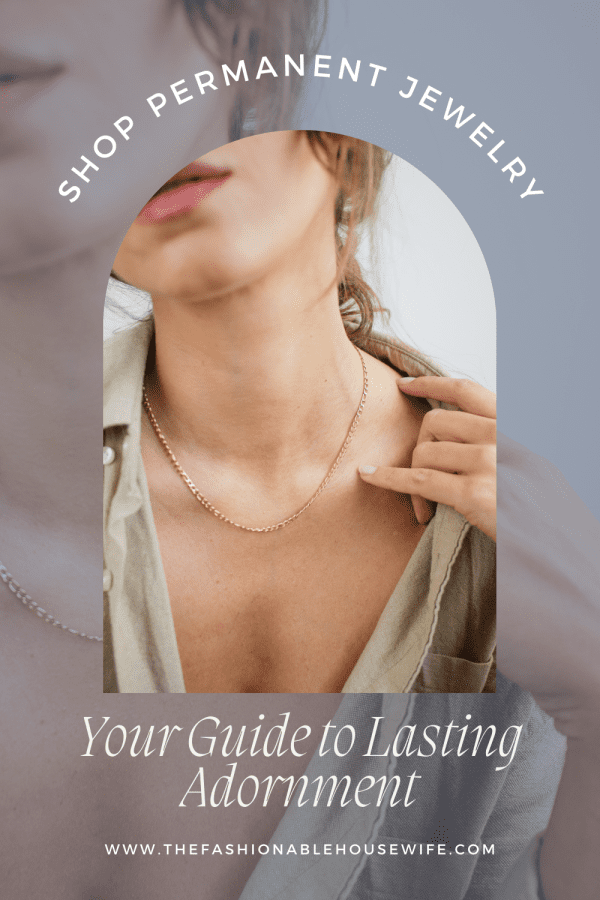
What is Forever Jewelry, and how is it applied?
Permanent jewelry, often lovingly called “forever jewelry,” represents a modern twist on adornment. Unlike traditional pieces with clasps that can be taken on and off, these items are custom-fitted and seamlessly welded onto your body, creating a continuous, clasp-free loop. This innovative approach ensures your jewelry remains a constant, effortless part of your everyday style.
The application process is surprisingly quick, painless, and highly personalized. It typically begins with a consultation where you choose your preferred chain style and material. Once selected, the jeweler carefully measures your wrist, ankle, or neck to ensure a perfect, comfortable fit. This custom sizing is crucial, as the goal is for the jewelry to feel like a second skin.
Next comes the “zapping” – the moment of welding. Using a specialized micro-welder, the jeweler joins the two ends of the chain with a tiny, precise spark. This process is entirely safe and doesn’t involve direct contact with your skin. You’ll typically wear protective eyewear, and the jeweler will place a small piece of leather or fabric between your skin and the chain to prevent any heat transfer. The flash, often described as a “zap,” is quick and creates a durable, seamless bond. The entire procedure typically takes only a few minutes, resulting in a beautiful, continuous piece of jewelry.
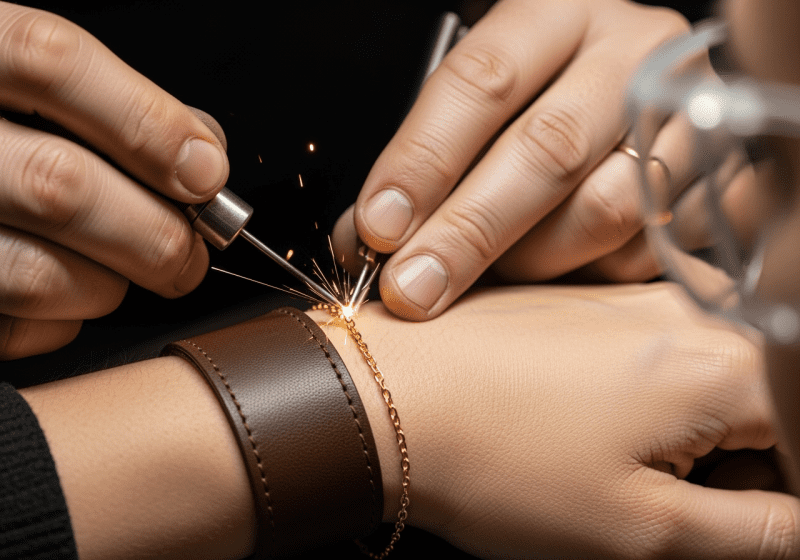
This method allows for various types of permanent jewelry, each offering a unique way to express yourself or commemorate a bond:
- Bracelets: The most popular choice, often worn individually or layered for a stacked look. They serve as a constant reminder of connection or personal intention.
- Anklets: A subtle yet stylish option, perfect for warmer climates or to add a touch of elegance to your footwear.
- Necklaces: While less common for permanent application, some opt for delicate, clasp-free necklaces that lie gracefully against the skin.
- Rings: Very fine, delicate rings can also be welded, offering a unique and minimalist approach to finger adornment.
The rising popularity of permanent jewelry isn’t just about aesthetics; it’s about the experience and the meaning behind it. Many consumers are seeking personalized and meaningful jewelry experiences, driving the popularity of services like permanent jewelry application. The ‘forever’ aspect appeals to a desire for lasting symbols of connection, commitment, or self-expression.
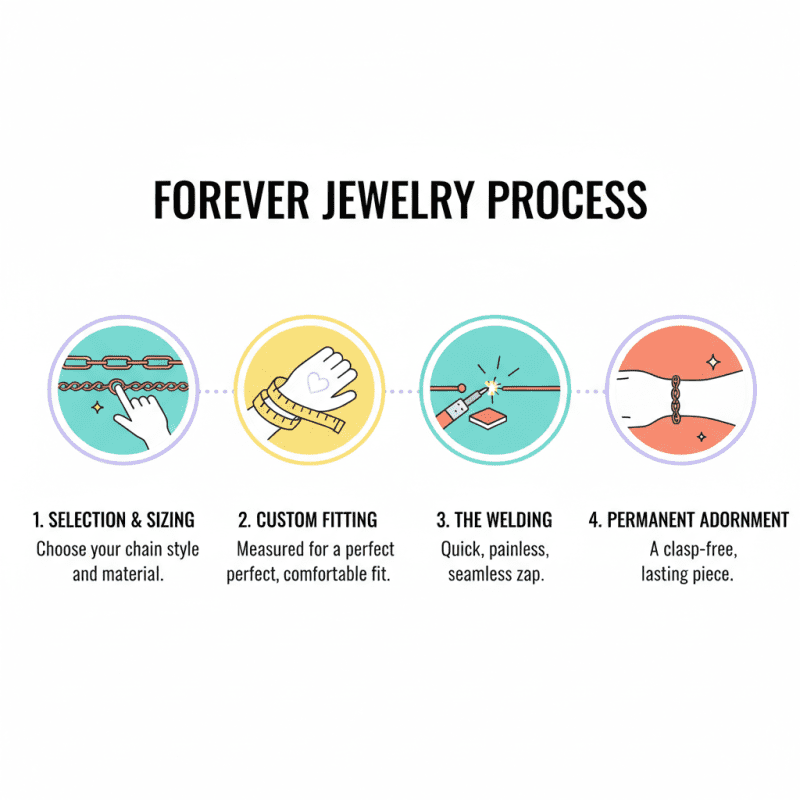
Choosing Your Perfect Piece: Materials and Styles
Selecting the right material and style for your permanent jewelry is key to ensuring its longevity and personal significance. The choice of material impacts not only the aesthetic but also the durability, hypoallergenic properties, and overall care requirements of your piece.
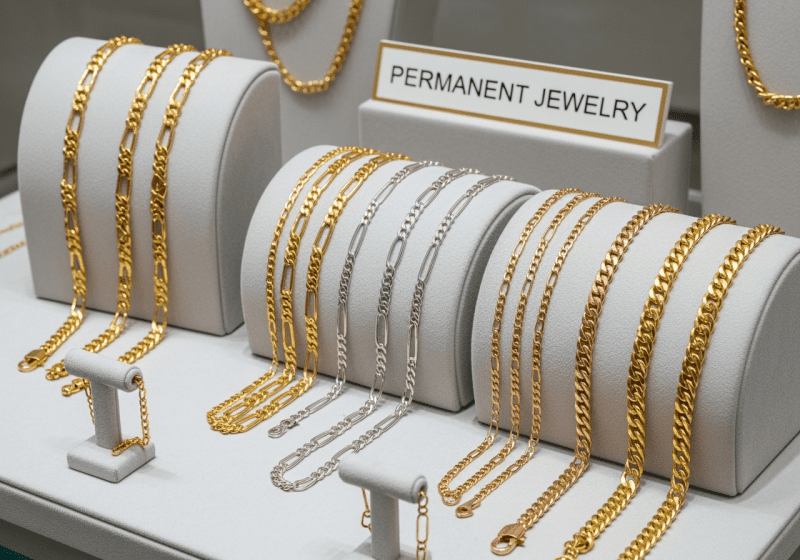
Common materials used for permanent jewelry include:
- 14 K Solid Gold: This is a top choice due to its enduring beauty, hypoallergenic properties, and resistance to tarnish. Solid gold is incredibly durable and maintains its value over time, making it a true “forever” option. It’s suitable for continuous wear and can withstand daily activities without losing its luster.
- Gold-Filled: A more affordable alternative to solid gold, gold-filled chains consist of a thick layer of solid gold mechanically bonded to a base metal, usually brass. This layer is significantly denser than gold plating, making it much more durable and resistant to tarnish. With proper care, gold-filled chains can last 10 to 30 years without fading or tarnishing.
- Sterling Silver: A classic and versatile option, sterling silver offers a beautiful, bright finish. While it can tarnish over time, it’s easy to clean and restore its shine. Sterling silver is also hypoallergenic for most people; however, those with extreme sensitivities may prefer solid gold.
- PVD Coated: Physical Vapor Deposition (PVD) coating is a modern technique that applies a thin, durable layer of metal (like gold) onto a base material. PVD-coated chains offer a sleek, scratch-resistant finish and maintain their color well, providing a durable and stylish option.
The ability to customize permanent jewelry with charms, initials, or diamonds adds to its appeal as a unique and personal item. Popular styles often feature dainty, minimalist chains that are comfortable for continuous wear and can be easily layered with other pieces.
Best Materials for Longevity
For a piece truly meant to last, 14k solid gold stands out as the superior choice. Its inherent properties mean it won’t tarnish, fade, or react with skin, ensuring it remains beautiful for decades. For those seeking a balance between luxury and affordability, gold-filled materials offer exceptional durability and a similar aesthetic to solid gold without the higher price point. As mentioned, these can last for many years with proper care. Sterling silver is also durable but requires more frequent cleaning to prevent tarnish. PVD coating offers an excellent, durable finish, particularly for those seeking modern, scratch-resistant options.
Popular Customization Options
The beauty of permanent jewelry lies in its personalization. You can create a one-of-a-kind piece that tells your story or symbolizes a special connection. Popular customization options include:
- Birthstones: Adding a small gemstone representing a birth month or a significant date.
- Initials: Charms with initials of loved ones, pets, or your own.
- Symbols: Meaningful symbols like hearts, stars, anchors, or infinity signs.
- Diamonds: Tiny, sparkling diamonds can be incorporated into charms or directly onto the chain for a touch of timeless elegance.
These additions transform a simple chain into a deeply personal talisman, making the jewelry not just an accessory but a testament of love, friendship, or self-expression.
Navigating the World of Leading Permanent Jewelry Solutions
The growing popularity of permanent jewelry means there are more options than ever to get your own lasting adornment. However, navigating this expanding market requires understanding the factors that influence cost, where to find reputable services, and what to expect from the experience.
The cost of permanent jewelry can vary significantly based on several factors:
- Material Choice: Solid gold will naturally be more expensive than gold-filled or sterling silver. The karat of gold (e.g., 14k vs. 10k) also plays a role.
- Chain Thickness and Style: Thicker or more intricate chain designs (like Cuban, Mariner, or Rope chains) will typically cost more per inch than very delicate, simple chains.
- Jeweler Location and Expertise: Prices can vary depending on the jeweler’s geographical location and their experience level. Established studios with a strong reputation may charge higher prices, reflecting their superior quality of service and materials.
- Customization: Adding charms, initials, birthstones, or diamonds will increase the overall price.
When seeking out a permanent jewelry service, you’ll find them in various settings:
- Dedicated Studios: Many businesses specialize solely in permanent jewelry, offering a wide range of chain options and a focused experience.
- Jewelry Boutiques: Traditional jewelers are increasingly adding permanent jewelry services to their offerings, often integrating it with their existing fine jewelry collections.
- Pop-Up Events: Permanent jewelry artists often host pop-up events at local markets, festivals, or private gatherings, making their services accessible to a broader audience.
- Private Parties: Some artists offer mobile services for private events, allowing groups of friends or family to get “zapped” together.
It’s essential to find professionals who offer leading permanent jewelry solutions to ensure a quality and safe experience. A reputable provider will prioritize safety, use high-quality materials, and have experienced technicians.
Understanding the Investment in Leading Permanent Jewelry Solutions
Permanent jewelry is an investment, not just in a piece of adornment, but in a lasting symbol. While prices vary, you can generally expect to pay per inch of chain, with additional costs for charms or welding fees. For example, a delicate 14k gold bracelet might range from $ 80 to $200+, depending on the length and specific chain style. Gold-filled options will be more affordable, typically priced between $40 and $100. Many providers offer clear price lists, and it’s always wise to inquire about the total cost, including any welding or re-welding fees, before your appointment.
The value proposition extends beyond the monetary cost; it encompasses the convenience of never having to remove your jewelry, the effortless style it provides, and the emotional significance it holds. For those considering starting their own permanent jewelry business, understanding how to price permanent jewelry for profit is crucial, and resources exist to guide you through this, such as insights on how to price jewelry for profit.
Finding Reputable Artists for Leading Permanent Jewelry Solutions
To ensure a positive and safe experience, thorough research is paramount. Here’s how to find reputable artists:
- Check Online Reviews and Portfolios: Look for jewelers with strong positive reviews, especially regarding hygiene, customer service, and the quality of their welds. Many artists showcase their work on social media platforms like Instagram, which can give you a good sense of their style and craftsmanship.
- Inquire About Materials: A professional artist will be transparent about the materials they use, confirming they are genuine 14k solid gold, gold-filled, or sterling silver, and discussing their hypoallergenic properties.
- Ask About Safety Protocols: Ensure they use appropriate safety measures, including protective eyewear for both client and artist, and barriers to protect your skin during the welding process.
- Book an Appointment or Visit a Pop-Up: Many studios recommend booking appointments, though some also welcome walk-ins. This allows you to discuss your options, ask questions, and get a feel for their service. You can often find booking links directly on their websites, such as those for “zapping” appointments in various cities.
For businesses seeking to source materials, understanding where to purchase wholesale permanent jewelry supplies is crucial for maintaining quality and profitability.
Living with Your Forever Jewelry: Care and Considerations
Once your permanent jewelry is “zapped” into place, it becomes a seamless extension of you. While designed for continuous wear, a little care and an understanding of potential considerations will ensure your piece remains beautiful and hassle-free.
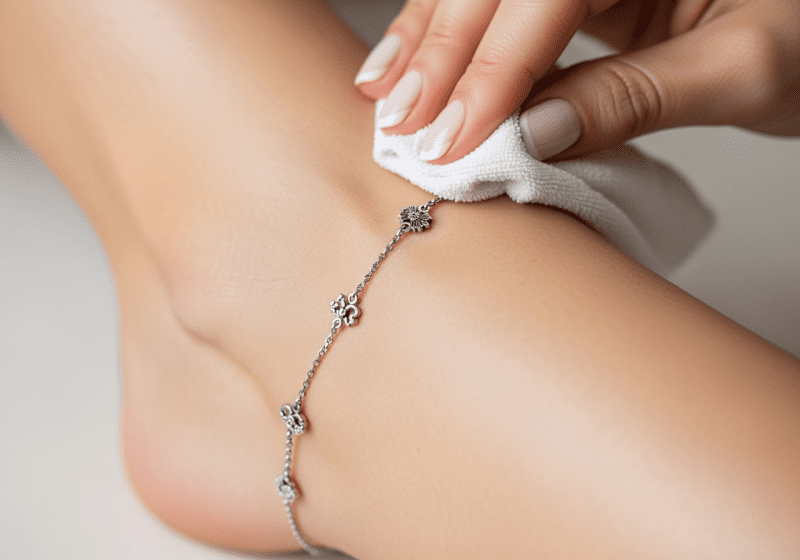
Daily Care: One of the significant benefits of permanent jewelry is its low maintenance requirements. You don’t need to take it off for showering, swimming, or sleeping. However, occasional cleaning will keep it sparkling:
- Mild Soap and Water: Clean your jewelry with a gentle, mild soap (such as dish soap) and warm water.
- Soft-Bristle Brush: Use a soft-bristle toothbrush to gently scrub away any dirt, lotions, or oils that might accumulate in the chain links.
- Polishing Cloths: For sterling silver, or to restore the shine of gold and gold-filled pieces, a jewelry polishing cloth can work wonders.
- Avoid Harsh Chemicals: Steer clear of harsh cleaning chemicals, chlorine, or abrasive materials, as these can damage the metal or dull its finish, especially for gold-filled or plated options.
Risks and Safety: While generally very safe, there are a few considerations:
- Metal Allergies: While 14k solid gold is highly hypoallergenic, some individuals may have sensitivities to other metals, particularly nickel, which can sometimes be present in gold-filled or plated jewelry. If you have known metal allergies, discuss this with your jeweler and opt for solid gold.
- Medical Procedures: This is a crucial consideration. Permanent jewelry typically needs to be removed for certain medical procedures, such as MRIs, CT scans, X-rays, or surgery, due to potential interference with magnetic fields or electrical currents. Always inform your medical provider about your permanent jewelry well in advance of any procedure. They can advise on whether removal is necessary.
- Airport Security: Generally, delicate permanent jewelry does not cause issues with airport security. The TSA typically does not make passengers remove fine jewelry. We have traveled far and wide with our Forever bracelets and have never had a problem.
- Pacemakers: Individuals with pacemakers are usually advised against getting permanent jewelry due to the welding process. Reputable jewelers will offer clasped versions of their styles as an alternative.
Removal Process: Despite its “forever” nature, permanent jewelry can be removed if necessary.
- Simple Removal: If you need to remove it for a medical procedure or wish to take a break, you can easily cut the chain with a pair of strong scissors or jewelry cutters. It’s best to cut at the jump ring (the small ring where the weld was made) to preserve the rest of the chain.
- Re-welding Options: Many jewelers offer a re-welding service for a small fee, allowing you to reattach your piece after removal. This typically falls within a warranty period, often around two years.
Frequently Asked Questions about Permanent Jewelry
We understand that committing to a “forever” piece comes with questions. Here are some of the most common inquiries we receive about permanent jewelry:
Does the permanent jewelry process hurt?
No, the process is completely painless! Despite the term “zapping” and the small flash, the micro-welder does not come into contact with your skin. A protective barrier is placed between the chain and your skin, ensuring no heat or sensation is felt. It’s a quick, safe, and often exciting experience.
Can I remove my permanent jewelry if I need to?
Yes, absolutely. While it’s designed to be permanent, it can be easily removed if needed for medical procedures, personal preference, or any other reason. We recommend using a pair of sharp scissors or jewelry cutters to snip the chain at the small jump ring where it was originally welded. Many studios also offer re-welding services if you wish to reattach it later.
How long does permanent jewelry last?
With proper care and the selection of high-quality materials, such as 14k solid gold or gold-filled, your permanent jewelry can last for many years, even decades. Its longevity largely depends on your lifestyle and the material chosen. While solid gold is the most durable, gold-filled chains are also known to last 10-30 years without tarnishing. Factors such as extreme tension, harsh chemicals, or accidental snagging can potentially break the chain; however, it’s designed for continuous wear.
Conclusion
Permanent jewelry offers a unique and meaningful way to adorn yourself, symbolizing lasting connections, personal intentions, or simply an effortless expression of style. From the custom-fitting and “zapping” process to the choice of durable materials, such as 14k gold necklaces and gold-filled options, each step is designed to create a piece that is truly yours, for good.
The rise of this trend reflects a deeper desire for personalized and significant adornment in an increasingly globalized world. Whether you’re commemorating a friendship, celebrating a milestone, or simply embracing a new form of self-expression, permanent jewelry provides a beautiful, low-maintenance, and enduring option. By understanding the process, materials, care, and considerations, you can confidently adopt this modern approach to wearing your story, making your chosen piece a true testament to lasting adornment.

